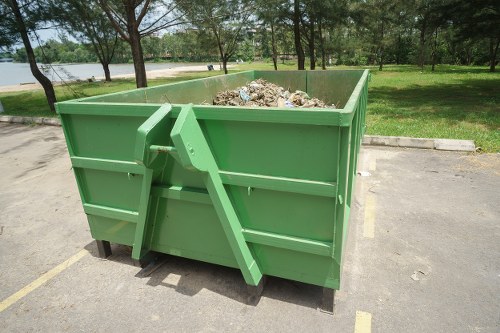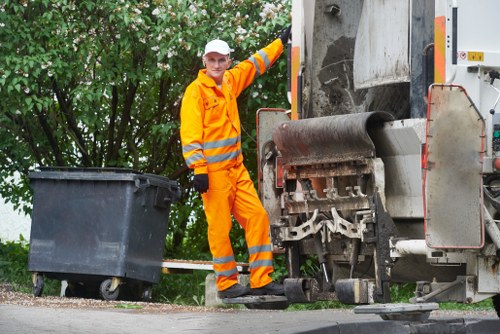Understanding and Managing Builders Waste in Bowes Park
Introduction to Builders Waste in Bowes Park

Builders waste is a serious concern for both local residents and construction professionals in Bowes Park. It includes unwanted materials generated from construction, demolition, and renovation projects, ranging from rubble and concrete to wooden scraps and metals. Effective management of this waste not only helps protect the local environment but also contributes to a cleaner, more sustainable community. In Bowes Park, this issue is addressed with a mix of modern recycling techniques and strict local regulations that ensure all builders waste is disposed of safely. This article provides a comprehensive overview of how builders waste is managed locally, its challenges, and the strategies used to reduce its impact. By understanding these aspects, you can be better prepared to make informed decisions when planning your construction or renovation project.
In many parts of the world, the disposal of construction waste is often seen as an afterthought. However, in Bowes Park, a proactive approach is taken to address this issue. Local businesses and municipal authorities collaborate to implement waste-reduction strategies that focus on recycling, reusing, and recovering valuables from materials that would otherwise end up in landfills. This focus on sustainability is supported by community education programs, ensuring that even newcomers to construction practices understand the importance of proper waste management. The benefits of such an approach extend beyond environmental health—they also improve local aesthetics and public safety.
Historically, the handling of builders waste in Bowes Park has evolved dramatically over the years. Advances in recycling technology, coupled with increased environmental awareness, have transformed previous waste disposal methods into modern systems that are both efficient and ecologically sound. Today, the community takes pride in its ability to manage large volumes of debris with minimal impact. Not only does this enhance the quality of life for residents, it also sets an example for neighboring districts. As a result, Bowes Park has become a model for responsible construction practices, showcasing how innovative waste management can be integrated into everyday community life.
Key Challenges of Builders Waste Disposal in Bowes Park

The process of disposing of builders waste is not without its challenges. One major issue is the variety of materials that need to be handled, each requiring a different disposal or recycling method. For instance, the treatment of concrete and brick rubble differs significantly from that of metals or wood, necessitating specialized facilities and trained personnel. In Bowes Park, one of the primary difficulties is maintaining quality separation at every stage of the process. Even minor contamination can disrupt recycling streams and lead to higher disposal costs. This challenge forces local authorities to continually adapt and upgrade their systems to ensure that waste is processed efficiently and responsibly.
Another challenge is the logistical aspect of waste collection. Given Bowes Park's dense urban environment, scheduling pick-ups for large volumes of waste requires careful planning. Routes must be organized to minimize traffic disruption and ensure that waste is collected in a timely manner. Construction companies often face tight deadlines, and delays in waste collection can lead to project setbacks or fines. Therefore, coordination between the various stakeholders is essential, involving not just waste management companies but also the local council and community organizations.
Additionally, there is a significant financial aspect tied to the disposal of builders waste. Recycling and reprocessing materials can be expensive, and the costs often need to be absorbed by construction companies. For those working on a tight budget, finding affordable yet compliant disposal options becomes a critical concern. The combination of rising costs, regulatory pressures, and the sheer variety of materials means that every project demands a customized approach. This has led to an increase in the number of specialized disposal services in Bowes Park, each providing tailored solutions to address the unique challenges faced by builders in the area.
Effective Builders Waste Management Strategies

To address the challenges posed by builders waste, a number of effective strategies have emerged in Bowes Park. One such strategy is the on-site separation of waste. By sorting materials at the source, construction sites can significantly reduce the risk of contamination. This approach ensures that recyclable materials like metal, glass, and certain plastics are kept separate from non-recyclable debris such as contaminated soil or mixed construction waste. Proper separation means that a larger proportion of waste can be recycled, reducing overall disposal costs and environmental impact. Many firms now implement clear labeling systems and designated storage areas to enhance this process.
Another popular strategy is the use of state-of-the-art recycling facilities. These centers are designed to handle large volumes of waste and are equipped to efficiently process multiple types of materials. In Bowes Park, such facilities not only recycle significant portions of waste but also contribute to the local economy by creating job opportunities and reducing the environmental burden on local landfills. The success of these recycling centers is largely due to rigorous quality control measures and the adoption of innovative technologies that allow for higher recycling rates and lower operational costs.
Furthermore, builders are encouraged to adopt the principle of reduction at the planning stage. This means considering waste generation right from the initial design phase and planning projects to minimize excess materials. Techniques such as modular construction and lean construction practices are becoming increasingly popular. These methods involve precise planning and the use of materials that generate less waste during assembly and disassembly. By incorporating these practices early on, builders in Bowes Park can achieve a higher level of sustainability and significantly reduce the volume of waste produced during a project.
Local Services and Regulations in Bowes Park

Local services and regulatory measures play a crucial role in ensuring effective builders waste management in Bowes Park. The local council has implemented strict rules and guidelines to manage the collection, sorting, and disposal of construction waste. These regulations mandate that all builders follow approved waste disposal procedures to prevent environmental contamination and promote recycling. Regular inspections and audits are conducted to ensure compliance, and businesses that fail to adhere to these standards may face penalties. This regulatory environment not only promotes accountability but also drives continuous improvement in waste management practices.
Local waste management companies also contribute significantly to the efficient disposal of builders waste in the area. These companies operate a fleet of specialized vehicles designed to handle heavy loads and various waste types. They work in close collaboration with construction firms to coordinate pick-ups, ensuring that waste is removed promptly and in a manner that complies with council regulations. The company teams are trained to handle hazardous materials safely, reducing the risk of pollution and health hazards for the community. Such professional services are vital for maintaining the high standards expected in Bowes Park.
In addition to operational services, educational initiatives aimed at raising awareness about sustainable waste management are widely promoted within Bowes Park. Workshops, seminars, and informational brochures are provided to construction companies and homeowners alike, stressing the importance of recycling and proper disposal techniques. These initiatives are supported by local environmental groups and involve community participation. By educating those involved in the construction process, Bowes Park ensures that everyone understands not only the legal requirements but also the environmental and economic benefits that come with proper waste management practices. This shared responsibility is at the heart of many successful local projects.
Nearby Areas and Their Impact on Builders Waste Management

Bowes Park is surrounded by a number of vibrant communities, each contributing to the overall fabric of the area. Builders waste management in Bowes Park is influenced not only by local practices but also by trends and initiatives in these surrounding neighborhoods. The proximity of areas with similar construction challenges means that strategies and innovations often cross over boundaries. For instance, recycling facilities in neighboring areas may also serve Bowes Park contractors, and shared knowledge about sustainable practices helps boost overall efficiency. The interconnection among these districts has paved the way for regional cooperation in waste management, thereby reducing both costs and environmental impacts.
The collaboration between Bowes Park and its neighbors has proven beneficial in multiple ways. Local authorities often work together to ensure that waste management infrastructure meets the demands of a growing population. Construction projects in nearby communities often share resources such as transportation services and recycling technologies, which further enhance the region's ability to address builders waste. This cooperation extends down to organizing joint training sessions and community events aimed at promoting environmental awareness. The cumulative effect is a more robust, regionally integrated approach to tackling construction waste, offering benefits that are felt by all involved parties.
Nearby Areas
This section gives an overview of some of the areas closest to Bowes Park and their unique characteristics related to builders waste and construction. The following list highlights each area along with a brief description of its proximity and contribution:
- Finsbury Park – Located just a few miles away, Finsbury Park is known for its vast green spaces and high density of residential areas, making efficient waste management crucial.
- Harringay – A bustling neighborhood with rapid development, Harringay frequently collaborates with Bowes Park on sustainable waste practices.
- Crouch End – Known for its community spirit and creative reuse initiatives, Crouch End serves as an inspiration for innovative recycling methods.
- Wood Green – A commercial and residential hub, Wood Green benefits from shared facilities that help streamline the disposal of construction waste.
- Palmers Green – With a focus on environmental conservation, Palmers Green actively supports local recycling initiatives.
- Tottenham – A vibrant area contributing to regional synergy, Tottenham’s waste reduction programs have a positive influence on Bowes Park practices.
- Muswell Hill – This affluent area places a strong emphasis on green practices, often leading in sustainable construction waste disposal.
- Highgate – Renowned for its historic and modern blend, Highgate collaborates on initiatives that address both heritage preservation and builders waste management.
- Edmonton – A diverse community where innovative waste solutions are implemented, Edmonton’s practices are closely monitored for efficiency.
- Archway – With strategic access to regional transport links, Archway plays a vital role in the logistics of waste collection and recycling.
- Stoke Newington – Known for its artistic communities and forward-thinking environmental policies, Stoke Newington supports sustainable waste initiatives.
- Upper Edmonton – This area provides additional recycling support and collaborates with Bowes Park to enhance overall waste management systems.
By aligning builders waste management strategies and sharing resources among these neighborhoods, the entire region is better positioned to tackle environmental challenges and support sustainable urban development. This collective effort lays the foundation for innovative practices that benefit all communities involved.
Additional Insights and Considerations
The discussion of builders waste in a localized context, such as Bowes Park, benefits from an integrated approach that considers both the practical and environmental aspects of construction. It is important to note that continuous research, policy updates, and community input all contribute to the final disposal strategies. This holistic viewpoint is essential for minimizing the long‐term footprint that construction projects leave on urban landscapes.
Moreover, collaborative efforts between government, private companies, and local residents ensure that these practices keep adapting to new technologies and challenges. In many cases, best practices from other regions are imported and adapted for local conditions. Innovative thinking combined with practical experience has led to many successful implementations that are now a model for similar communities across the country.
Looking forward, the future of builders waste management in Bowes Park seems promising with ongoing advances in sorting and recycling technologies. Continuous improvements in policy and public awareness will likely create even more efficient systems, ultimately reducing the environmental impact of even the largest construction projects.
Conclusion
In summary, builders waste management in Bowes Park is a multi-faceted challenge that involves not just the safe disposal of construction debris, but also sustainable practices that benefit the entire community. From proper waste separation at the source to the adoption of cutting-edge recycling technologies, every step is designed to minimize the negative impact of builders waste. The cooperation between neighboring areas further strengthens these efforts, ensuring that the knowledge and resources are shared among all communities.
The emphasis on local regulations and community-based initiatives makes Bowes Park a leader in environmental conservation related to construction activities. Building on a foundation of well-organized waste management systems, the community successfully combines economic growth with sustainability. This strategy, characterized by long-term thinking and continuous improvement, stands as a testament to what can be achieved when regulatory frameworks and community engagement go hand in hand.
Ultimately, whether you are a contractor, a resident, or simply someone interested in environmental sustainability, understanding the challenges and strategies employed in Bowes Park can provide valuable insights into modern waste management. Embracing these practices not only improves the quality of construction projects but also contributes to a healthier, cleaner future for all.
Frequently Asked Questions
Q1: What constitutes builders waste?
A1: Builders waste includes all unwanted materials generated from construction, demolition, or renovation projects. This may consist of concrete, wood, metals, and mixed debris that require specialized disposal or recycling methods.
Q2: How does Bowes Park handle separation of builders waste on site?
A2: Many construction sites in Bowes Park practice on-site separation, where different waste types are sorted into designated containers. This helps prevent cross-contamination and ensures that recyclable materials are processed efficiently.
Q3: Can builders waste be recycled?
A3: Yes, a considerable portion of builders waste can be recycled. Materials such as metal, certain plastics, bricks, and concrete are commonly recycled, reducing the overall environmental impact and decreasing disposal costs.
Q4: How do local services support builders waste management in Bowes Park?
A4: Local waste management companies collaborate with the Bowes Park council to provide specialized collection services, maintain recycling facilities, and enforce strict compliance with disposal regulations, ensuring safe and efficient processing of waste.
Q5: What nearby areas influence builders waste practices in Bowes Park?
A5: Areas such as Finsbury Park, Harringay, Crouch End, Wood Green, Palmers Green, Tottenham, Muswell Hill, Highgate, Edmonton, Archway, Stoke Newington, and Upper Edmonton all contribute by sharing resources and best practices, enhancing regional recycling and waste disposal strategies.
